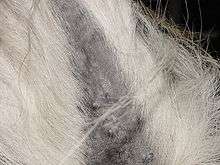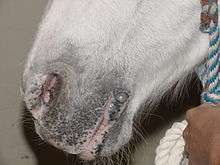Equine Melanoma

An equine melanoma is a tumor that results from the abnormal growth of melanocytes in horses. Unlike human melanomas, they are not thought to be caused by exposure to ultraviolet light.[1] Melanomas are the third most common type of skin cancer in horses, with sarcoids being the first most prevalent and squamous-cell carcinoma being second.[2] They are typically rounded black nodules that vary in size and can usually be found underneath the dock of the tail, the anal, perianal and genital regions, perineum, lips, eyelids, and sometimes near the throatlatch.[3]
These tumors can be either benign, meaning not cancerous, or malignant, meaning cancerous;[4] while the benign tumors typically need little treatment to no treatment, the malignant tumors can cause serious problems and can potentially be life-threatening.[5] Different methods are used to determine if the tumor is malignant and if it has spread to other organs. Methods used to determine malignancy include fine needle aspirate, biopsy, or complete removal.[4] To determine if the tumor has metastasized, a rectal examination or an ultrasound can be performed; the most frequent location for metastasis include the lymph nodes, spleen, liver, the abdominal wall, the lungs, and blood vessels.[6] If the tumor becomes large enough, it can cause weight loss or colic. It may also affect the horse’s ability to turn their head from side to side and eat and drink comfortably if the tumor is on the throat latch area, or cause faecal impaction if tumor is on the anal region.[3] These tumors can also be a serious issue if they have metastasized or if they become large and ulcerate, bleed, then become infected.[5]
Melanoma in Grey Horses

Grey horses have a higher susceptibility to melanoma than any other coat color, with up to 80% of grey horses developing some kind of melanoma in their lifetime [4] and some sources state that 66% of those melanoma's will become malignant.[3] The grey coat color cannot be considered a base color, but rather a gene that is responsible for the gradual depigmentation of the horse’s coat; horses with this gene are born darker and over time, they lose their coat pigmentation.[5] The fading of the coat color may happen over years, but once the pigmentation is gone it will not return.[5] This grey gene is the strongest coat modifier, and will act on any base color regardless of the horse’s phenotype.[5] The grey coat color is the result of an autosomal dominate trait that is caused by a 4.6-kb duplication in the 6th intron of the gene syntaxin-17 (STX17).[7] The region of this mutation contains four genes: NR4A3 (nuclear receptor subfamily 4, group A, member 3), STX17, TXNDC4 (thioredoxin domain–containing-4¢) and INVS (inversin).[7] To determine what makes grey horses more susceptible to melanoma's, researchers have used different techniques such as the Northern Blot technique [8] and Real-Time PCR.[9] From these studies, it was concluded that the STX17 gene and the NR4A3 gene are both being over expressed in grey horses, which is responsible for the increased incidences of melanoma in horses with the grey gene.[7]
Different Types of Melanoma
Not all melanoma tumors are the same; there are four different types of melanomas that can be found in horses.
Melanocytic nevi
This type of tumor is found in younger horses, around 5 years of age, and are usually benign. They can develop on horses of any color as small (less than 2.5 cm), single masses and can be found anywhere on the body.[10]
Dermal melanoma
These tumors are usually benign, but can become malignant over time. They vary in size, and can be found as singles or multiples. They are most commonly found in mature grey horses (less than 15 years old) and are typically found under the tail, around the anus, and on the external genitalia.[10]
Dermal melanomatosis
These tumors are frequently malignant and have a high tendency to spread to other organs. They are most commonly found in grey horses who are over the age of 15 and are found as a large coalescing mass under the tail, around the anus, on the external genitalia, or the parotid salivary gland.[10]
Anaplastic melanoma
These tumors are malignant and frequently spread to other organs. They are rare, however when they do occur, they are typically found in older (more than 20 years of age) non-grey horses.[10]
Treatment
Since 80% of grey horses will develop a melanoma tumor at some point in their lives, it is important to know what kind of treatments are available. There are several treatment options when a horse is found to have a melanoma tumor including surgical or injections:
Surgical removal
The surgical removal of a melanoma tumor is performed when the tumors are small; this prevents the tumors from spreading to the surrounding areas.[11]
Intralesional Cisplatin
Cisplatin is a chemotherapy drug that is injected into the tumor itself; this drug is commonly used along with surgical removal. That being said, this drug has been shown to resolve tumors with or without surgical removal for at least 2 years.[12]
Cimetidine
Cimetidine works by slowing tumor growth; it is a histamine blocker that maintains the body’s immune response which aids in the killing of tumor cells. Cimetidine has not been proven to efficiently resolve tumors completely.[13]
Melanoma vaccine
A vaccine that is similar to the effective canine melanoma vaccine [14] has been created for equine melanoma and is being studied at the College of Veterinary Medicine at the University of Florida [4]
References
- ↑ "NADIS - National Animal Disease Information Service -". www.nadis.org.uk. Retrieved 2016-11-26.
- ↑ Valentine (2006). "Survey of equine cutaneous neoplasia in the Pacific Northwest". J Vet Diagn Invest. 18.
- 1 2 3 Moore, J. S; Shaw, E; Buechner‐Maxwell, V; Scarratt, W. K; Crisman, M; Furr, M; Robertson, J (2013). "Melanoma in horses: Current perspectives". Equine Veterinary Education. 25: 144–151.
- 1 2 3 4 Tannler, B (2013). "Equine Melanoma" (PDF). Equine Health Update. 15: 1–2.
- 1 2 3 4 5 "Gray Coat Color/ Melanoma". www.horsetesting.com. Retrieved 2016-11-26.
- ↑ MacGillivray, K., Sweeney, R., & Piero, F. (2002). Metastatic Melanoma in Horses. Journal of Veterinary Internal Medicine, 16(4), 452-456.
- 1 2 3 Pielberg, G., Golovko, A., Sundström, E., Curik, I., Lennartsson, J., Seltenhammer, M., Druml, T., Binns, M., Fitzsimmons, C., Lindgren, G., Sandberg, K., Baumung, R., Vetterlein, M., Strömberg, S., Grabherr, M., Wade, C., Lindblad-Toh, K., Pontén, F., Heldin, C., Sölkner, J., and Andersson, L. (2008). A Cis-acting Regulatory Mutation Causes Premature Hair Graying and Susceptibility to Melanoma in the Horse. Nature Genetics 40(8), 1004
- ↑ "Northern Blotting". www.lifetechnologies.com. Retrieved 2016-11-26.
- ↑ Wang, X., Seed, B. (2003). A PCR primer bank for quantitative gene expression analysis. Nucleic Acids Research, 31(24), e154; 1-8
- 1 2 3 4 Valentine, B.A. (1995). Equine melanocytic tumors: A retrospective study of 53 horses (1988 to 1991). Journal of Veterinary Internal Medicine, (5), 291-297.
- ↑ Rowe, E.L., & Sullins, K.E. (2004). Excision as treatment of dermal melanomatosis in horses: 11 cases (1994-2000). Journal of the American Veterinary Medical Association, 225(1), 94-96.
- ↑ Hewes, C.A., & Sullins, K.E. (2006). Use of cisplatin-containing biodegradable beads for treatment of cutaneous neoplasia in Equidae: 59 cases (2000-2004). Journal of the American Veterinary Medical Association, 229(10), 1617-1622.
- ↑ Goetz, T. E., Ogilvie, G. K., Keegan, K. G., and Johnson, P. J. (1990). Cimetidine for treatment of melanomas in three horses. J Am Vet Med Assoc. 196(3), 449-52.
- ↑ Bergman, P.J., Camps-Palau, M.A., Mcknight, J.A., Leibman, N.F., Craft, D.M., Leung, C., Liao, J., Riviere, I., Sadelain, M., Hohenhaus, A.E., Gregor, P., Houghton, A.N., Perales, M.A., Wolchok, J.D. (2006). Development of a xenogeneic DNA vaccine program for canine malignant melanoma at the Animal Medical Center. Vaccine, 24(21), 4582-4585.